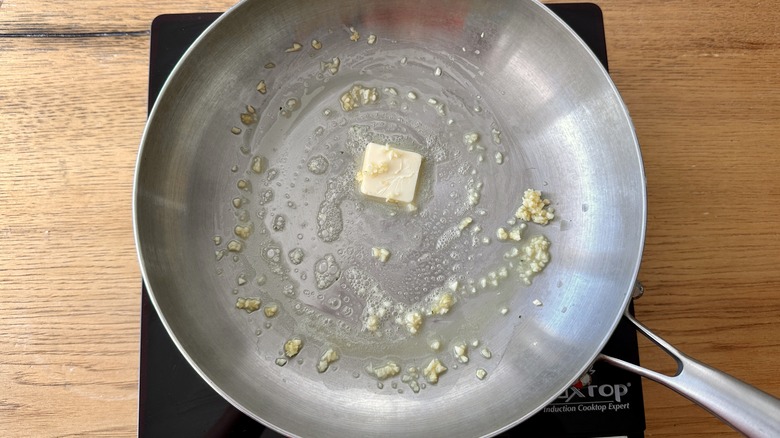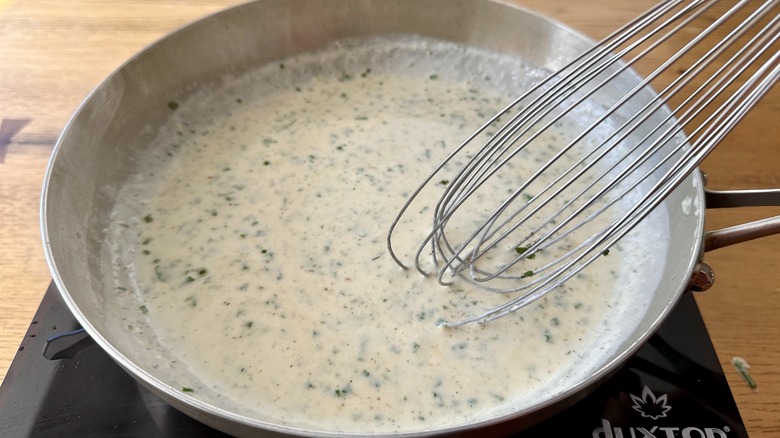Parmesan-Crusted Salmon With Creamy Herb Sauce Recipe
Omega 3-rich salmon is one of the healthiest types of fish you can eat, and by a stroke of fortune, it also happens to be one of the tastiest. If there's one thing that can make salmon even better, though, that would be the addition of cheese. As developer Katie Rosenhouse says of her decked-out salmon recipe, "Is there a dish that can't be enhanced with a touch of Parmesan?" The Parmesan crust, she tells us, complements the rich, fatty fish with its salty savoriness, while the breadcrumbs add a "satisfying crunch." As a finishing touch, she tops off the fish fillets with a herb-enhanced bechamel sauce for optimal decadence.
Rosenhouse likes to serve this salmon with a side of green beans or asparagus, while a green salad with a tangy lemon vinaigrette like the one Ina Garten makes would also be the perfect accompaniment. If you'd like something starchy as well, rice or roasted potatoes would work, as would a side of pasta dressed with melted butter and Parmesan.
Collect the ingredients for Parmesan-crusted salmon with creamy herb sauce
This dish starts with salmon fillets coated in a mixture of panko breadcrumbs, Parmesan cheese, chopped parsley, melted butter, salt, and pepper. To make the sauce, you'll also need white wine, heavy cream, garlic, Dijon mustard, lemon zest, chives, and flour.
Step 1: Turn on the oven
Preheat the oven to 425 F.
Step 2: Prepare a pan
Line a small baking sheet with aluminum foil and spray to coat with cooking spray. Set aside.
Step 3: Season the breadcrumbs
In a small bowl, stir to combine panko, Parmesan, 1 tablespoon chopped parsley, ⅛ teaspoon salt, and ⅛ teaspoon pepper.
Step 4: Stir in some butter
Add 3 tablespoons melted butter and mix to combine. Set aside.
Step 5: Salt and pepper the salmon
Season the salmon fillets on both sides with salt and pepper.
Step 6: Place the salmon on the pan
Transfer the salmon to the prepared baking sheet, spacing each fillet at least 1 inch apart.
Step 7: Sprinkle salmon with crumbs
Top evenly with panko mixture.
Step 8: Cook the salmon
Bake for 12 to 15 minutes until golden brown and the internal temperature of the salmon reaches 145 F.
Step 9: Saute the garlic
In the meantime, prepare the sauce: Heat butter and garlic in a medium skillet over low heat, stirring, until garlic is fragrant and butter is melted.
Step 10: Stir in the flour
Add flour and cook, stirring, for 1 minute.
Step 11: Add the wine
Whisk in wine and bring to a simmer.
Step 12: Add the cream
Slowly whisk in cream, and cook, whisking, until thickened enough to coat the back of a spoon.
Step 13: Season the sauce
Remove sauce from heat and whisk in mustard, lemon zest, and herbs. Season to taste with salt and pepper.
Step 14: Pour the sauce over the salmon
Spoon sauce over cooked salmon and serve hot with rice, veggies, and other side dishes as desired.
Parmesan-Crusted Salmon With Creamy Herb Sauce Recipe
This salmon recipe comes decked-out with a Parmesan-panko crust and a creamy, herby bechamel sauce on top.

Ingredients
- For the Parmesan topping
- ½ cup plain panko breadcrumbs
- ½ cup grated Parmesan cheese
- 1 tablespoon chopped parsley
- ⅛ teaspoon kosher salt
- ⅛ teaspoon ground black pepper
- 3 tablespoons unsalted butter, melted
- For the salmon
- 1 pound salmon filets
- salt, to taste
- pepper, to taste
- For the creamy herb sauce
- 1 tablespoon unsalted butter
- 1 clove minced garlic
- 1 tablespoon all-purpose flour
- ½ cup white wine
- ¾ cup heavy cream
- 1 teaspoon Dijon mustard
- Zest of ½ lemon
- 1 tablespoon finely chopped parsley
- 1 tablespoon finely chopped chives
- salt, to taste
- pepper, to taste
Directions
- Preheat the oven to 425 F.
- Line a small baking sheet with aluminum foil and spray to coat with cooking spray. Set aside.
- In a small bowl, stir to combine panko, Parmesan, 1 tablespoon chopped parsley, ⅛ teaspoon salt, and ⅛ teaspoon pepper.
- Add 3 tablespoons melted butter and mix to combine. Set aside.
- Season the salmon fillets on both sides with salt and pepper.
- Transfer the salmon to the prepared baking sheet, spacing each fillet at least 1 inch apart.
- Top evenly with panko mixture.
- Bake for 12 to 15 minutes until golden brown and the internal temperature of the salmon reaches 145 F.
- In the meantime, prepare the sauce: Heat butter and garlic in a medium skillet over low heat, stirring, until garlic is fragrant and butter is melted.
- Add flour and cook, stirring, for 1 minute.
- Whisk in wine and bring to a simmer.
- Slowly whisk in cream, and cook, whisking, until thickened enough to coat the back of a spoon.
- Remove sauce from heat and whisk in mustard, lemon zest, and herbs. Season to taste with salt and pepper.
- Spoon sauce over cooked salmon and serve hot with rice, veggies, and other side dishes as desired.
Nutrition
| Calories per Serving | 839 |
| Total Fat | 63.8 g |
| Saturated Fat | 31.6 g |
| Trans Fat | 0.7 g |
| Cholesterol | 208.0 mg |
| Total Carbohydrates | 15.8 g |
| Dietary Fiber | 1.5 g |
| Total Sugars | 2.9 g |
| Sodium | 763.9 mg |
| Protein | 43.4 g |
How can I switch up the Parmesan-crusted salmon or creamy sauce?
If you don't have panko breadcrumbs, you can use the regular kind in this recipe, or you can make your own from leftover bread or croutons. You could also go low-carb with a crust made from crushed nuts or pork rinds. As for the cheese, a different type of hard, firm cheese such as pecorino Romano, asiago, or manchego could be used in place of the Parmesan.
For the sauce, you can use milk, plain yogurt, or cream cheese as a substitute for the heavy cream. You can also make an alcohol-free version by using white wine vinegar mixed 50-50 with water as a substitute for the wine. If you want to save time making it, you can always use a jar of pre-made hollandaise. Stir in some chives and parsley if you've got them, and maybe add another squeeze of lemon to brighten the flavor. You could also opt for store-bought alfredo sauce since its Parmesan flavor would complement the cheese in the crust.
How can I tell when the salmon is done cooking?
One of the biggest mistakes you can make when cooking salmon is messing up the timing. If you undercook it, this brings the risk of foodborne illness or a less-than-desirable texture. This problem can be easily fixed by keeping the fish in the oven a few minutes longer, but overcooked fish is harder to resurrect. It tends to be dry and rubbery and can also leave a lingering smell in the house.
The best way to determine whether your salmon is done is to use a meat thermometer. Once the internal temperature reads 145 F, it's time for the fish to come out of the oven. While a thermometer should always be your first line of defense, you can also use a backup method like poking the fish with a fork. If you can flake the flesh easily, it should be done.


















